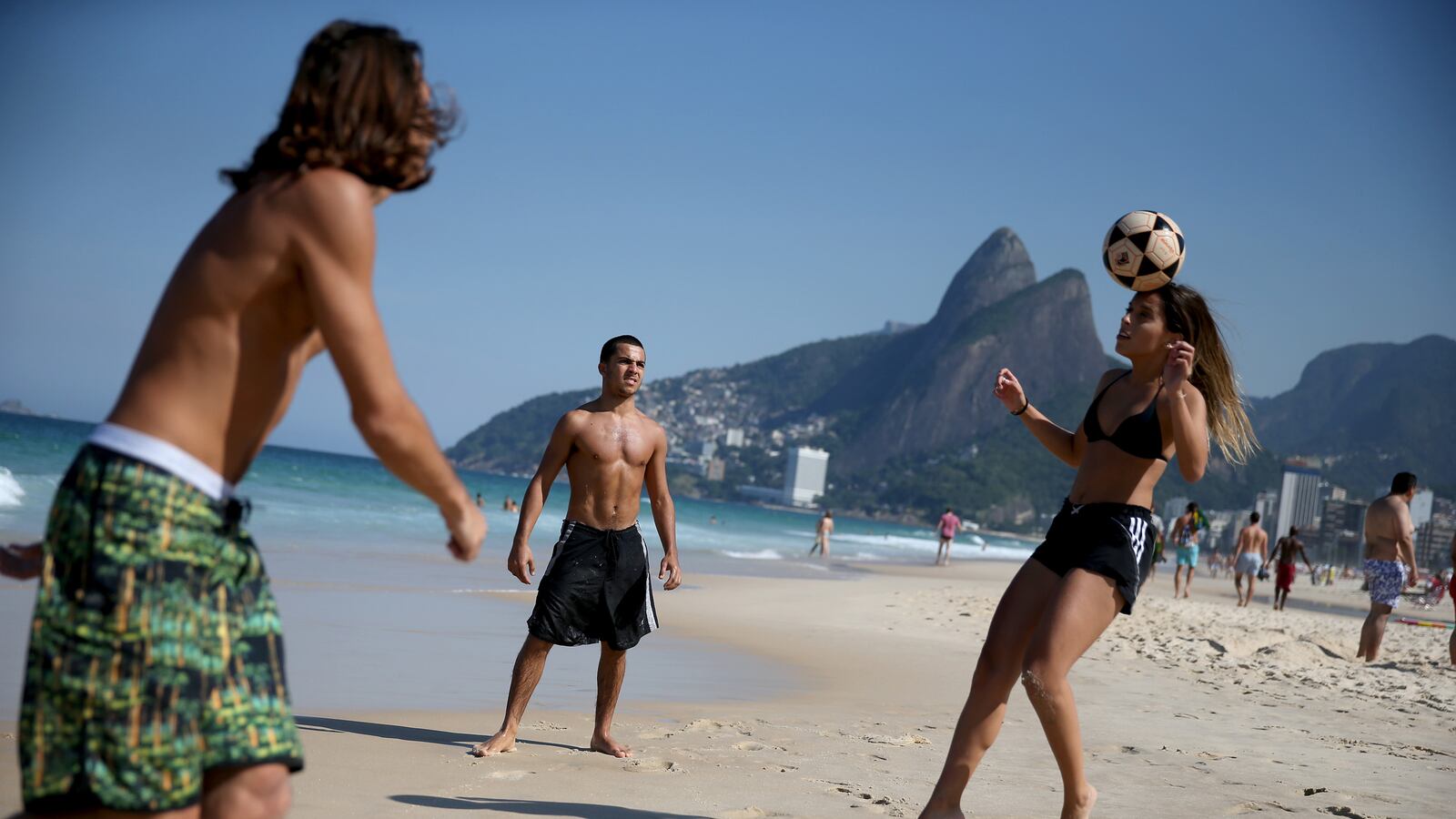Thud. Bump. Swish. A single white ball arcs up into the baby blue sky before zooming back down to the ground at great speed. It’s sunrise on Ipanema in Rio de Janeiro, and the entire beach is empty save four young men eager to practice their sport. Eyes focused, they’re evenly spaced across the sand to keep the ball in play. The early hours are a testament to their dedication—if they want to take on the pros during daylight they’re going to need a few more years of practice.

If you thought this was football (or soccer) then you’re mistaken. This is footvolley.
Although Brazil has a mean case of FIFA fever as the World Cup kicks into high gear, it’s footvolley that’s really taken Rio by storm—a ruthless combination of football and volleyball, in which the rules of each game somehow come together to form an even more rigorous sport.
Played two against two, footvolley uses the no-hands rulebook of association football, and combines the sets, scorekeeping and court parameters of volleyball. It’s the hallmark activity of Ipanema, and it’s so wildly popular that daytime matches are strictly reserved for the most talented players.
The game is the latest trend to bloom on the world’s most famous beach, immortalized in song by Antônio Carlos Jobim’s A Garota de Ipanema, or as the English-speaking world knows it, “The Girl From Ipanema.” Written in 1962 with lyrics by Vinicius de Moraes, the tune reached every corner of the globe sparking pop culture’s obsession with finding out the true identity of the garota in question. A day spent on Ipanema offers a fascinating vision of the breadth and diversity of Rio society, rich and poor.
Besides the early-morning whirr of the footvolley hopefuls, the only other sound on the sand at dawn is the rusty clinking of makeshift tents being unfolded with incredible efficiency.
Every day before 6 a.m. legions of beach vendors leave their shanties in nearby Vidigal and the other neighboring favelas to construct their temporary businesses from scratch. These tents form an intricate retail ecosystem that can be loosely divided into two parts: barracas and ambulantes.
The crudely assembled pavilions, or barracas, are evenly spaced along the beach like little base camps offering chairs and umbrellas for rent, not to mention an assortment of food and beverages. The ambulantes are the sweat-on-the-brow beach hawkers who carry a variety of goods directly to your tanning spot. The barraca managers and ambulantes are simpatico in their daylong quest to pocket gobs of hard-earned money.
The beauty of Ipanema’s beach retail culture is that you can practically get anything you want simply by raising your hand. And while the peddlers make a small fortune selling a variety of items—the Rio Times reported that a bikini vendor can make up to R$4,000 (around $1,800 USD) per day—it’s the snacks that are of particular interest to most.
Rio’s isn’t famous for its cuisine, but the beach food is in a class of its own. Burly men hoist large steel drums, one with sweet tea made from mate, the other with lemonade—“most locals like to mix them together, like an Arnold Palmer,” says Mikael Castro, who runs the private inbound travel services for Kensington Tours.
Skinnier hawkers stealthily circulate cooking queijo cualho (toasted cheese on a stick) in makeshift tin kettles. “Having an open fire on the beach is totally illegal, but it’s everyone’s favorite snack,” Castro adds. At the barracas you’ll find hand-blended caipirinhas and skirt steak sandwiches.
Although it may seem that the barraca workers and ambulantes deal in the exchange of pocket change for drinks and snacks, the city’s beach vending culture is actually an economic outlier in a nation suffering from a crippling fiscal slump.
In an economy that surged forward by leaps and bounds throughout the naughts, Brazil’s gross domestic product has fallen over the last few years—a financial dip that remains completely unmitigated by the World Cup, according to pundits. In fact, massive overspending for the Games could lead to a noticeable increase in taxes next year.
Beach vending in Rio, however, continues to grow by a whopping 20% margin per annum. In fact, according to the city’s Department of Social Enterprise and Development (the Secretaria de Desenvolvimento Econômico Solidário in Portuguese), the industry has been valued at over $2 billion Brazilian reals (roughly $900 million USD), and it both directly and indirectly employs roughly 240,000 people.
Hundreds of makeshift barracas mark their territory in the sand long before the sun heats up the curling mosaics along the sidewalk. They wait in anticipation of the throngs in thongs.
After sleeping off a long night’s worth of partying, the Cariocas—or Rio natives—make their way to sea in droves. But when they arrive at Ipanema an interesting phenomenon occurs: sunbathers immediately split off in different directions, as though everyone owns their own unspoken plot in the dunes. They wander toward what the locals call postos, creating a subculture safari informed by the beach’s interesting history and the value of real estate nearby.
Punctuating the sand from end to end, postos are the permanent lifeguard stands that act like beacons. The most well known posto on Ipanema is Posto 9, which apparently became the haven for the city’s counterculture after socialist politico Fernando Gabeira was spotted wearing a crocheted speedo. Today it still attracts an alternative crowd who enjoys intellectual banter and marijuana in equal parts.
The walk from Posto 9 to Posto 8 is the territory of the city’s gay population intermixed with other open-minded individuals, and at Posto 8 itself, you’ll uncover the unofficial playground of the local favelados.
As posto numbers increase in the other direction, you reach Leblon, arguably the wealthiest area in the entire city, and a more staid environment to perfect your tan. At Posto 11 are the tweens of the elite, who are endeavoring their independence by sitting slightly down the beach from their parents at Posto 12.
Seemingly impervious to the gravitational pull of the postos, celebrities and their model entourages strut along the beach like a sandy catwalk. They take selfies with their iPhones, wear the latest trends to garner aspirational stares from the Bieber lovers at Posto 11, and get judge-y looks from the gays near Posto 9 who undress them with their eyes, then dress them back up again in different outfits.
Ipanema has long been the hotbed of beach apparel, launching looks like the tanga and the g-string. Fashion icons still to this day use the sands to try out new styles. “The easiest way to tell the difference between a local and foreigner is by the size of their bikini—if you can see a swimsuit from the back then they’re definitely not from here,” teases Castro. Another faux pas: tourists sit on towels and locals never do (they sit on their sarongs or on beach chairs).
After a full day on sand with your caipirinha in hand amid footvolley superstars, tufts of ganja smoke, models donning dental floss, and a cloudless banner of blue sky up above, you’ll realize that the girl in Jobim’s song was merely an abstraction of the beach itself. She has that effect on people.






